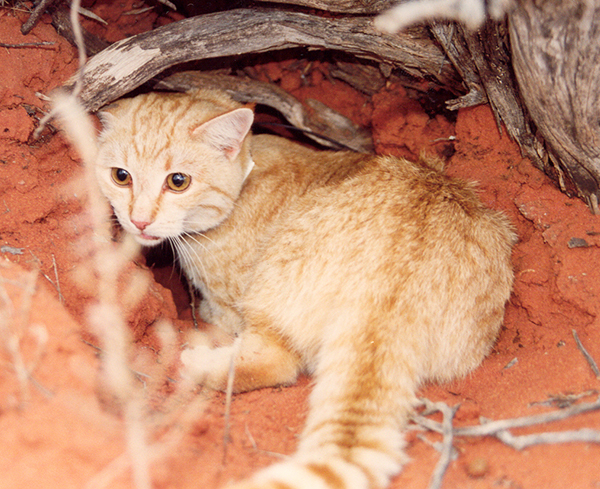Feral cat
Feral cats have been in the Northern Territory (NT) for over 100 years and have adapted to all habitats, from rainforests to the desert.
Impact
Feral cats are a serious threat to conservation of biodiversity in the NT.
They can impact native animals in all of the following ways:
- direct predation
- competition for food and shelter
- disease.
Direct predation
Feral cats have played a role in the loss and extinction of native animals, particularly in Central Australia.
Overall 63 species of native vertebrate have been found in the stomachs of feral cats, including mammals, reptiles, birds and amphibians.
Competition
There is a lack of evidence on the effects of competition between feral cats and native species.
It is assumed that species similar to cats, such as the western and northern quolls, now have to compete for food, habitat, shelter and other resources.
Competition can also occur between cats and predatory birds.
Cats may reduce prey for raptors such as the brown goshawk and the peregrine falcon.
There is also a possibility of competition with larger reptiles such as elapid snakes and goannas that prey on a range of vertebrates similar to those taken by feral cats.
Disease
Cats can spread disease to native animals and humans.
Toxoplasmosis has been recorded in several dasyurids species - carnivorous marsupials such as quolls - although its impact on population numbers is unknown.
Management
It is difficult to control feral cats in the NT, with the main methods being trapping or baiting.
Trapping
Cage traps are often preferred over leg hold traps, as fewer injuries are sustained and non-target animals can be released unharmed.
Check with your local council, who may have traps you can hire for feral cats. They may also provide you with options for their management in your area.
If you have trapped a feral cat, you should euthanise it in a humane manner.
This can be done by:
- an authorised person at an animal shelter, council pound or veterinarian
- shooting it while still in the cage at a site away from urban and residential areas.
Baiting
Baiting is not an appropriate control method in urban and residential areas due to potential impacts on:
- domestic pets
- native wildlife.
However, new commercial technologies are being developed that can deliver poison to cats while avoiding other species.
More information
For more information about feral cats, watch the video below.
To find out more about managing feral cats, go to the PestSmart website.
Give feedback about this page.
Share this page:
URL copied!
